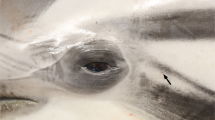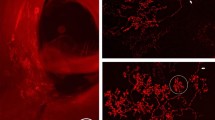Abstract
DE CASTRO'S histological1 and Heyman's physiological2 investigations on the carotid body have provided new and important evidence of a peripheral control of respiration and circulation. Histologically, much work has been done to elucidate the mode of nervous innervation of the chemo-receptive tissue in the carotid body; but little is known of the underlying mechanism by which chemical changes in the blood give rise to afferent impulses in the sinus nerve, for example, whether the receptors concerned are specialized in relation to the nature and concentration of particular stimuli. Anderson and Zotterman3 were able to demonstrate that specialized receptors for ‘water taste’ as distinct from acid receptors exist in the frog's tongue. Von Euler, Liljestrand and Zotterman4 obtained results “which strongly suggest identical receptors” for anoxic and hypercapnic stimulation. Winder5 leaves open the question of separate receptor sets for oxygen and carbon-dioxide stimulation.
This is a preview of subscription content, access via your institution
Access options
Subscribe to this journal
Receive 51 print issues and online access
$199.00 per year
only $3.90 per issue
Buy this article
- Purchase on Springer Link
- Instant access to full article PDF
Prices may be subject to local taxes which are calculated during checkout
Similar content being viewed by others
References
de Castro, F., Z. Anat. Entw., 89, 250 (1929).
Heymans, C., Bouchaert, J. J., and Dautreband, L., Arch. int. Pharmacodyn., 39, 400 (1930).
Anderson, B., and Zotterman, Y., Acta Phys. Scand., 20, 95 (1950).
von Euler, U. S., Liljestrand, G., and Zotterman, Y., Scand. Arch. Phys., 83, 132 (1939).
Winder, C. V., Amer. J. Physiol., 118, 389 (1937).
de Castr, F., Lab. Rec. Biol., 24, 367 (1926).
Riegele, L., Z. Anat. Entw., 86, 142 (1928).
White, E. G., Beitr. Path. Anat., 96, 177 (1935).
de Boissezon, P., Ann. d'Anat. Path., T13, 6, 733 (1936).
Meijling, H. A., Proc. Kon. Akad. Wet., Amsterdam (1936).
Nonidez, I. F., J. Anat., 70, 2, 215 (1936).
Holmes, W., “Microt. Vademecum”, 537 (11th Edit., 1950).
Author information
Authors and Affiliations
Rights and permissions
About this article
Cite this article
DE KOCK, L. Histology of the Carotid Body. Nature 167, 611–612 (1951). https://doi.org/10.1038/167611b0
Issue Date:
DOI: https://doi.org/10.1038/167611b0
This article is cited by
-
Light and electron microscopic observations on the carotid bodies of rats following adaptation to high altitude
Virchows Archiv B Cell Pathology (1975)
-
Adenosine triphosphatase activity in the carotid body of the cat
Zeitschrift f�r Zellforschung und Mikroskopische Anatomie (1972)
-
Elektronenmikroskopischer Beitrag zur Kenntnis des Glomus caroticum (Katze)
Zeitschrift f�r Zellforschung und Mikroskopische Anatomie (1971)
-
Über den Katecholamin-Stoffwechsel des Carotiskörperchens der Ratte
Virchows Archiv B Cell Pathology (1969)
-
Histochemical characteristics of chemoreceptor organs (Glomera)
Histochemie (1967)
Comments
By submitting a comment you agree to abide by our Terms and Community Guidelines. If you find something abusive or that does not comply with our terms or guidelines please flag it as inappropriate.



